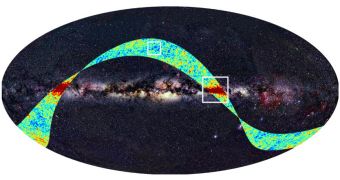The recently launched Planck telescope finally began to observe the Universe on August 13th, during a test-observation period. Built specifically by the European Space Agency (ESA) to analyze the Cosmic Microwave Background (CMB), the relic radiation left behind when the Cosmos first exploded into being, the telescope is now the coldest object in the known Universe. It circles the Sun in a Lagrangian orbit, in the L2 point, alongside ESA's other large observatory, the Herschel Space Telescope, AlphaGalileo reports.
The two-week first light survey began on August 13th, after the calibration of all subsystems on the satellite, and the cool-down of its instruments' detectors was achieved. The telescope's mission is to survey the sky and detect variations in the CMB temperature that are equivalent to measuring the body heat of a rabbit located on the Moon. It was therefore cooled to temperatures close to absolute zero (–273.15°Celsius, or zero Kelvin).
The goal of the tests was to determine whether Planck's instruments were stable enough to allow for the precise observations that were planned for it. Additionally, mission controllers needed to determine whether its detectors could be precisely tuned enough to allow for the subtle variations in the CMB temperature, which are about a million times smaller than one degree, to be detected. The final conclusions of the trial period were drawn on August 27th, when the first light test officially concluded.
From preliminary analyses of the first data obtained by the spacecraft, analysts have determined that the quality of the observations is excellent, and have announced that they are very optimistic in regards to the success that Planck will have in fulfilling its mission. The analyzed strip of sky was photographed in all of the telescope's nine frequencies, and is represented by a 15-degree-wide ring for each of the individual photos.
Now that the preliminary results are in, Planck will begin a 15-month, non-stop survey, which is aimed at collecting sufficient data for assembling its first all-sky survey. The earliest map is expected to be created within six months, mission experts say. The two maps that the observatory will put together in its lifetime will most likely keep astronomers and astrophysicists busy for years to come.

 14 DAY TRIAL //
14 DAY TRIAL //